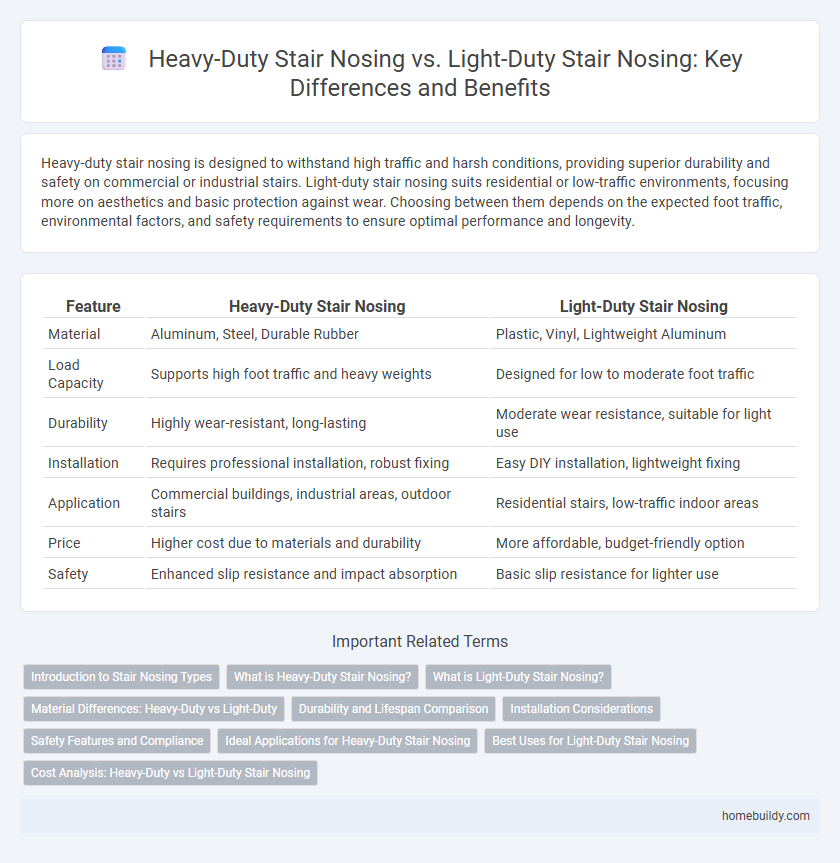Heavy-duty stair nosing is designed to withstand high traffic and harsh conditions, providing superior durability and safety on commercial or industrial stairs. Light-duty stair nosing suits residential or low-traffic environments, focusing more on aesthetics and basic protection against wear. Choosing between them depends on the expected foot traffic, environmental factors, and safety requirements to ensure optimal performance and longevity.
Table of Comparison
| Feature | Heavy-Duty Stair Nosing | Light-Duty Stair Nosing |
|---|---|---|
| Material | Aluminum, Steel, Durable Rubber | Plastic, Vinyl, Lightweight Aluminum |
| Load Capacity | Supports high foot traffic and heavy weights | Designed for low to moderate foot traffic |
| Durability | Highly wear-resistant, long-lasting | Moderate wear resistance, suitable for light use |
| Installation | Requires professional installation, robust fixing | Easy DIY installation, lightweight fixing |
| Application | Commercial buildings, industrial areas, outdoor stairs | Residential stairs, low-traffic indoor areas |
| Price | Higher cost due to materials and durability | More affordable, budget-friendly option |
| Safety | Enhanced slip resistance and impact absorption | Basic slip resistance for lighter use |
Introduction to Stair Nosing Types
Heavy-duty stair nosing is designed for high-traffic commercial and industrial environments, offering superior durability and enhanced slip resistance with materials like aluminum or stainless steel. Light-duty stair nosing suits residential or low-traffic applications, typically made from vinyl or rubber for basic protection and aesthetic appeal. Selecting the appropriate stair nosing type ensures safety compliance, extends stair longevity, and addresses specific usage demands.
What is Heavy-Duty Stair Nosing?
Heavy-duty stair nosing is designed for high-traffic commercial and industrial environments, providing enhanced durability and slip resistance. It is typically constructed from robust materials such as aluminum or stainless steel and features reinforced edges to withstand heavy wear and impact. This type of stair nosing ensures safety and longevity in areas subjected to frequent foot traffic and heavy loads.
What is Light-Duty Stair Nosing?
Light-duty stair nosing is designed for areas with low to moderate foot traffic, providing safety and edge protection without heavy reinforcement. Typically made from materials like aluminum or vinyl, it enhances slip resistance and prevents wear on stair edges in residential or light commercial settings. This type of stair nosing balances durability with aesthetic appeal, making it ideal for environments where heavy impact is minimal.
Material Differences: Heavy-Duty vs Light-Duty
Heavy-duty stair nosing is typically constructed from high-strength materials such as aluminum alloys, stainless steel, or reinforced rubber, designed to withstand intense foot traffic and industrial environments. Light-duty stair nosing often uses materials like PVC, vinyl, or basic aluminum, suitable for residential or low-traffic commercial areas where durability demands are minimal. The material selection directly impacts the nosing's resistance to wear, impact, and environmental factors, defining its suitability for heavy or light-duty applications.
Durability and Lifespan Comparison
Heavy-duty stair nosing is constructed from robust materials like aluminum or steel, offering superior durability and resistance to heavy foot traffic, making it ideal for commercial or industrial environments. Light-duty stair nosing, typically made from PVC or rubber, provides adequate protection and lifespan for residential or low-traffic applications but may wear out faster under constant use. The lifespan of heavy-duty stair nosing commonly exceeds 10 years, while light-duty options usually last between 3 to 5 years depending on usage and maintenance.
Installation Considerations
Heavy-duty stair nosing requires reinforced anchoring systems and precise alignment due to its robust materials suited for high-traffic industrial environments. Light-duty stair nosing, designed for residential or low-traffic areas, allows for simpler installation methods such as adhesive bonding or fewer mechanical fasteners. Proper substrate preparation and compatibility with stair materials remain critical for both types to ensure durability and safety.
Safety Features and Compliance
Heavy-duty stair nosing offers enhanced slip resistance and impact durability, ensuring maximum safety in high-traffic or industrial environments where strict OSHA and ADA compliance is required. Light-duty stair nosing provides adequate slip resistance and edge protection for residential or low-traffic areas, meeting basic safety standards without the reinforced materials found in heavy-duty options. Both types are designed to improve visibility and reduce trip hazards, but heavy-duty variants typically incorporate abrasive surfaces and robust profiles to withstand rigorous safety regulations.
Ideal Applications for Heavy-Duty Stair Nosing
Heavy-duty stair nosing is designed for high-traffic and industrial environments, providing enhanced durability and slip resistance on commercial staircases, warehouses, and manufacturing plants. It withstands heavy loads, frequent foot traffic, and harsh conditions, making it ideal for safety compliance in workplaces and public buildings. Compared to light-duty options, heavy-duty stair nosing offers superior protection against wear and damage, extending the lifespan of stair treads in demanding settings.
Best Uses for Light-Duty Stair Nosing
Light-duty stair nosing is best suited for residential and low-traffic commercial environments where minimal wear and tear occur. It provides sufficient protection against edge damage and enhances safety on interior stairs without the need for heavy reinforcement. Ideal materials include PVC or aluminum with non-slip surfaces, ensuring durability and safety while maintaining aesthetic appeal.
Cost Analysis: Heavy-Duty vs Light-Duty Stair Nosing
Heavy-duty stair nosing generally incurs higher initial costs due to robust materials like aluminum or stainless steel designed for high-traffic and industrial environments. Light-duty stair nosing, often made from vinyl or rubber, offers a more budget-friendly option suitable for residential or low-traffic areas, balancing cost with adequate durability. Evaluating long-term maintenance and replacement expenses highlights that heavy-duty options may deliver better value in heavy-use settings despite the upfront investment.
Heavy-duty stair nosing vs Light-duty stair nosing Infographic

 homebuildy.com
homebuildy.com